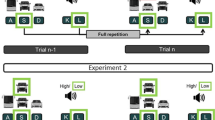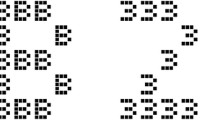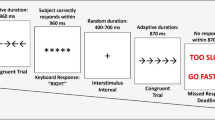Abstract
We adopted the Psychological Refractoriness Paradigm to study whether perceptual Goodness affects the load of central processing resources. In three dual-task experiments, 2-Alternative Forced Choice auditory classification was followed by a same–different task in which Garner’s classical five-dot patterns were presented. Goodness of these patterns and stimulus-onset asynchrony (SOA) between the first and second task were varied between trials. These factors had additive effects on response latencies and accuracy, indicating that pattern Goodness determines central processing load in performing the same–different task. In a fourth experiment, same–different judgment with Garner patterns was the single task. SOA between the first and second pattern was varied. Over-additive effects of Goodness with decreasing SOA were obtained, indicating sharing of central resources between consolidation of the first Garner pattern and performing the same–different task. Whereas, the resources needed for the latter, again, depend on Goodness, those needed for consolidation are independent of it.





Similar content being viewed by others
Notes
It was shown that in addition to response-selection, at least parts of the encoding stage require central capacity in certain conditions (Jolicoeur & Dell’ Acqua, 1998).
Van Selst and Jolicoeur (1994) found under-additive interaction of mental rotation and SOA and concluded that at least some of the orientation-sensitive processes can operate in parallel with central processes of the first task.
Only data entered the analysis of which RT met the following criterion: (RT < [μis+3σis|145 ms < RT< general speed criterion]) & (RT > [μ + 1.5σ|145 ms < RT < general speed criterion]), with μis = mean and σis = standard deviation of RT for the ith participant on the sth session and μ = mean and σ = standard deviation of RT, general speed criterion = 1,000 ms for the first task and 2,000 ms for the second task.
For model fit, instead of β (R 2), we used the parameter R 2 adj = adjusted R 2 for low degree of freedom = R 2 − ([1 − R 2] a)/(b– a*), with a = number of independent variables; b = sum of case weights; a* = number of coefficients (including intercept). R 2 adj is displayed when R 2 differs, i.e., when the significance is higher for R 2.
References
Bell, H. H., & Handel, S. (1976). The role of pattern Goodness in the reproduction of backward masked patterns. Journal of Experimental Psychology: Human Perception and Performance, 2, 139–150.
Berti, S., Geissler, H.-G., Lachmann, T., & Mecklinger, A. (2000). Event-related brain-potentials dissociate visual working memory processes under categorical and identical comparison conditions. Cognitive Brain Research, 9, 147–155.
Checkosky, S., & Whitlock, D. (1973). The effects of pattern Goodness on recognition time in a memory search task. Journal of Experimental Psychology, 100, 341–348.
Chipman, S., Mendelson, M. J., & Morton, J. (1979). Influence of six types of visual structure on complexity judgments in children and adults. Journal of Experimental Psychology: Human Perception & Performance, 5, 365–378.
Clement, D. E., & Varnadoe K. W. (1967). Pattern uncertainty and the discrimination of visual patterns. Perception and Psychophysics, 2, 427–431.
Corballis, M. C., & Beale, I. L. (1970). Bilateral symmetry and behavior. Psychological Review, 77, 451–464.
Davis, R. (1959). The role of attention in the psychological refractory period. Quarterly Journal of Experimental Psychology, 11, 211–220.
De Jong, R. (1993). Multiple bottlenecks in overlapping task performance. Journal of Experimental Psychology: Human Perception and Performance, 19, 965–980.
Enns, J. T. (1987). A developmental look at pattern symmetry in perception and memory. Developmental Psychology, 23, 839–850.
Fagot, C., & Pashler, H. (1992). Making two responses to a single object: Implications for the central attentional bottleneck. Journal of Experimental Psychology: Human Perception & Performance, 18, 1058–1079.
Garner, W. R. (1962). Uncertainty and structure as psychological concepts. New York: Wiley.
Garner, W. R. (1966). To perceive is to know. American Psychologist, 21, 11–19.
Garner, W. R., & Clement, D. E. (1963). Goodness of pattern and pattern uncertainty. Journal of Verbal Learning and Verbal Behavior, 2, 446–452.
Garner, W. R., & Sutliff, D. (1974). The effect of Goodness on encoding time in visual pattern discrimination. Perception and Psychophysics, 16, 426–430.
Gottschaldt, K. (1926). Über den Einfluß der Erfahrung auf die Wahrnehmung von Figuren. Teil I: Über den Einfluß gehäufter Einprägung von Figuren auf ihre Sichtbarkeit in umfassenden Konfigurationen. [About the influence of experience to the perception of figures]. Psychologische Forschung/Psychological Research, 8, 261–283.
Heil, M., Rauch, M., & Hennighausen, E. (1998). Response preparation begins before mental rotation is finished: Evidence from event-related brain potentials. Acta Psychologica, 99, 217–232.
Heil, M., Wahl, K., & Herbst, M. (1999). Mental rotation, memory scanning, and the central bottleneck. Psychological Research, 62, 48–61.
Henderson, J. M. (1997). Transsacadic memory and integration during real-world object perception. Psychological Science, 8, 51–55.
Herbert, A. M., & Humphrey, G. K. (1996). Bilateral symmetry detection: Testing a “callosal” hypothesis. Perception, 25, 463–480.
Hogeboom, M. & van Leeuwen, C. (1997). Visual search strategy and perceptual organization covary with individual preference and structural complexity. Acta Psychologica, 95, 141–164.
Howe, E. S. (1980). Effects of partial symmetry, exposure time, and backward masking on judged Goodness and reproduction of visual patterns. Quarterly Journal of Experimental Psychology, 32, 27–55.
Howe, E. S., & Brandau, C. J. (1980). The temporal course of visual pattern encoding: Effects of pattern Goodness. Quarterly Journal of Experimental Psychology: Human Experimental Psychology, 35, 607–633.
Irwin, D. E. (1991). Information integration across saccadic eye movements. Cognitive Psychology, 23, 420–456.
Jolicoeur, P., & Dell’ Acqua, R. (1998). The demonstration of short-term consolidation. Cognitive Psychology, 36, 138–202.
Kahneman, D. (1973). Attention and effort. New York: Prentice Hall.
Kanizsa, G. (1985). Seeing and thinking. Acta Psychologica, 59, 23–33.
Kanizsa, G. (1994). Gestalt theory has been misinterpreted, but has also had some real conceptual difficulties. Philosophical Psychology, 7, 149–162.
Krueger, L. E. (1978). A theory of perceptual matching. Psychological Review, 85, 278–304.
Kubovy, M., & Wagemans, J. (1995). Grouping by proximity and multistability in dot lattices: A quantitative Gestalt theory. Psychological Science, 6, 225–234.
Lachmann, T., & Geissler, H. G. (2002). Memory search instead of template matching? Memory-guided inference in same–different performance. Acta Psychologica, 111, 283–307.
Lachmann, T., & Geyer, T. (2003). Letter reversals in reading—Is the case really closed? A critical review and conclusions. Psychology Science, 45, 50–70.
Lachmann, T., & van Leeuwen, C. (2004). Memory-guided inference in same–different comparison tasks. In C. Kaernbach, E. Schroeger, & H. J. Müller (Eds.), Psychophysics beyond sensation. Scientific psychology series (pp. 199–221). Hilldale, NJ: Erlbaum.
Lachmann, T., & van Leeuwen, C. (2005a). Individual pattern representations are context-independent, but their collective representation is context-dependent. Quarterly Journal of Experimental Psychology: Human Experimental Psychology, 57 (in press).
Lachmann, T., & van Leeuwen, C. (2005b). Task-invariant Aspects of Goodness in Perceptual Representation. Quarterly Journal of Experimental Psychology: Human Experimental Psychology, 57 (in press).
Logan, G. D., & Delheimer, J. A. (2001). Parallel memory retrieval in dual-task situations: II. Episodic memory. Journal of Experimental Psychology: Learning, Memory, and Cognition, 27, 668–685.
McCann, R. S., & Johnston, J. C. (1992). Locus of the single-channel bottleneck in dual-task interference. Journal of Experimental Psychology: Human Perception and Performance, 18, 471–484.
Millspaugh, J. R. (1979). Effects of array organization on same–different judgments. Perception and Psychophysics, 23, 27–35.
Navon, D., & Miller, J. (2002). Queuing or sharing? A critical evaluation of the single-bottleneck notion. Cognitive Psychology, 44, 193–251.
Palmer, S. E. (1985). The role of symmetry in shape perception. Acta Psychologica, 59, 67–90.
Pashler, H. (1984). Processing stages in overlapping tasks: Evidence for a central bottleneck. Journal of Experimental Psychology: Human Perception & Performance, 10, 358–377.
Pashler, H. (1989). Dissociations and dependencies between speed and accuracy: Evidence for a two-component theory of divided attention in simple tasks. Cognitive Psychology, 21, 469–514.
Pashler, H., & Johnston, J. C. (1989). Chronometric evidence for central postponement in temporally overlapping tasks. Quarterly Journal of Experimental Psychology, 41, 19–45.
Peterson, M. A., & Hochberg, J. (1983). Opposed-set measurement procedure: A quantitative analysis of the role of local cues and intention in form perception. Journal of Experimental Psychology: Human Perception and Performance, 9, 183–193.
Pomerantz, J. R. (1977). Pattern Goodness and speed of encoding. Memory and Cognition, 5, 235–241.
Pomerantz, J. R., & Lockhead, G. R. (1994). Perception of structure: An overview. In G. R. Lockhead & J. R. Pomerantz (Eds.), The perception of structure (pp. 1–20). Washington, DC: American Psychological Association.
Proctor, R. W. (1981). A unified theory for matching task phenomena. Psychological Review, 88, 291–326.
Ruthruff, E., Miller, J. O., & Lachmann, T. (1995). Does mental rotation require central mechanisms? Journal of Experimental Psychology: Human Perception and Performance, 21, 552–570.
Schubert, T. (1999). Processing differences between simple and choice reactions affect bottleneck localization in overlapping tasks. Journal of Experimental Psychology: Human Perception and Performance, 25, 408–425.
Schumacher, E. H., Seymour, T. L., Glass, J. M., Fencsik, D. E., Lauber, E. J., Kieras, D. E., et al. (2001). Virtually perfect time sharing in dual-task performance: uncorking the central cognitive bottleneck. Psychological Science, 12, 101–108.
Schweickert, R. (1978). A critical path generalization of the additive factor method: Analysis of a Stroop task. Journal of Mathematical Psychology, 18, 105–139.
Sebrechts, M. M., & Garner, W. R. (1981). Stimulus-specific processing consequences of pattern Goodness. Memory and Cognition, 9, 41–49.
Shepard, R. N., & Metzler, J. (1971). Mental rotation of three-dimensional objects. Science, 171, 701–703.
Sternberg, S. (1966). High-speed scanning in human memory. Science, 153, 652–654.
Sternberg, S. (1969). The discovery of processing stages: Extensions of Donders’ method. Acta Psychologica, 30, 276–315.
Stins, J. F., & van Leeuwen, C. (1993). Context influence on the perception of figures as conditional upon perceptual organization strategies. Perception and Psychophysics, 53, 34–42.
Telford, C. W. (1931). The refractory phase of voluntary and associative responses. Journal of Experimental Psychology, 14, 1–36.
Tombu, M., & Jolicoeur, P. (2002). All-or-none bottleneck vs capacity sharing accounts for the psychological refractory period phenomenon. Psychological Research, 66, 274–286.
Van Leeuwen, C., & Van den Hof, M. (1991). What has happened to Praegnanz? Coding, stability, or resonance. Perception and Psychophysics, 50, 435–448.
Van Selst, M., & Jolicoeur, P. (1994). Can mental rotation occur before the dual-task bottleneck? Journal of Experimental Psychology: Human Perception & Performance, 20, 905–921.
Van Lier, R., & Wagemans, J. (1997). Perceptual grouping measured by color assimilation: Regularity vs proximity. Acta Psychologica, 97, 37–70.
Van Selst, M., Ruthruff, E., & Johnston, J. C. (1999) Can practice eliminate the Psychological Refractory Period effect? Journal of Experimental Psychology: Human Perception & Performance, 25, 1268–1283.
Vince, M. A. (1948). The intermittency of control movements and the psychological refractory period. British Journal of Psychology, 38, 149–157.
Wagemans, J. (1993). Skewed symmetry: A nonaccidental property used to perceive visual forms. Journal of Experimental Psychology: Human Perception and Performance, 19, 364–380.
Welford, A. T. (1952). The “psychological refractory period” and the timing of high-speed performance—a review and a theory. British Journal of Psychology, 43, 2–19.
Wertheimer, M. (1923). Untersuchungen zur Lehre der Gestalt II. [Investigation into Gestalt theory] Psychologische Forschung/Psychological Research, 4, 301–351.
Wolfe, J. M., Cave, K. R., & Franzel, S. L. (1989). Guided search: An alternative to the feature integration model for visual search. Journal of Experimental Psychology: Human Perception and Performance, 15, 419–433.
Acknowledgements
This work was supported by Grant La 1281/2-1 from the Deutsche Forschungsgemeinschaft (DFG) to Thomas Lachmann. Many thanks are due to Krisztin Pataki (TU Berlin), Annett Geiler, Kristin Neumann, and Karsten Zander (University of Leipzig) for technical support and to Peter Frensch, Mike Tombu and two anonymous reviewers for helpful comments on an earlier draft of this paper.
Author information
Authors and Affiliations
Corresponding author
Rights and permissions
About this article
Cite this article
Lachmann, T., Leeuwen, C.v. Goodness takes effort: perceptual organization in dual-task settings. Psychological Research 71, 152–169 (2007). https://doi.org/10.1007/s00426-005-0001-y
Received:
Accepted:
Published:
Issue Date:
DOI: https://doi.org/10.1007/s00426-005-0001-y




